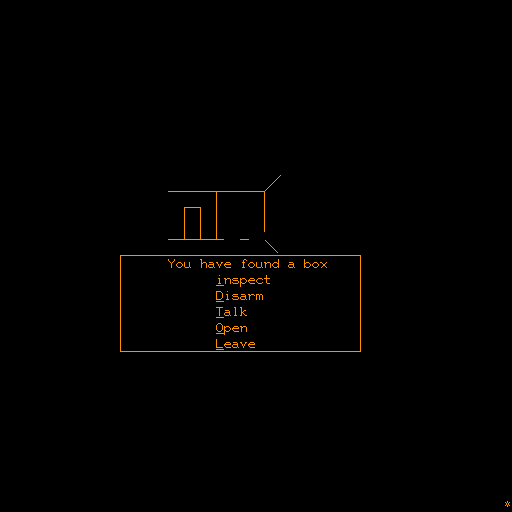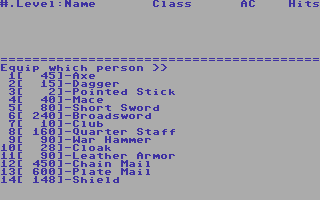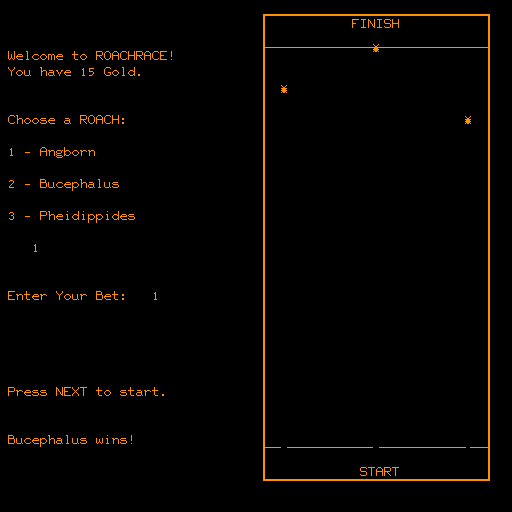Retro Replay Review
Gameplay
Oubliette’s core loop revolves around assembling and guiding a party of one to six adventurers through an ever-shifting, multilevel dungeon. Players choose from Fighters, Priests, and Thieves, each bringing distinct strengths: Fighters excel in melee combat, Priests wield divine magic for healing and protection, and Thieves handle traps and reconnaissance. Between dungeon delves, you return to the local tavern to swap out characters, manage aging, and even mourn fallen heroes. This blend of party customization and permadeath creates a tense risk-versus-reward dynamic that remains compelling decades after the game’s debut.
The hack-and-slash combat is deceptively simple: move your characters through corridors, encounter monsters, and issue attack or spell commands in real time. Magic is handled through typed activation codes—a nod to the era’s penchant for command-line interfaces—which adds a layer of authenticity and challenge. Memorizing spells adds depth: one mistyped code can mean the difference between slaying a giant ogre or accidentally healing it. This method slows the pace but also heightens immersion, making each spellcaster a specialist whose knowledge you must guard carefully.
Exploration and resource management are at the heart of Oubliette’s gameplay. As characters earn experience, they gain levels, discover jewelry and new armor, and become more resilient against the dungeon’s perils. However, aging is automatic: every trip down the stairs advances time, and older characters face an increasing chance of natural death. Balancing seasoned veterans with fresh recruits from the tavern becomes a strategic puzzle. It’s this open-ended design—no fixed quests or linear story beats—that encourages repeated playthroughs and inventive approaches to surviving the depths.
Graphics
By modern standards, Oubliette’s visuals are extremely minimalistic. The game uses primitive, top-down glyphs for dungeon walls, monsters, and items. Walls might be represented by hash marks (#), while floor spaces are dots or blank tiles. This ASCII-inspired aesthetic demands player interpretation, turning every corridor into a mental mapping exercise rather than a guided tour. For some, this retro charm enhances the feeling of discovery; for others, it can feel austere and abstract.
Character and monster representations are equally sparse. A Fighter’s helmet could be nothing more than a capital “F,” and a ghost might appear as a floating “G.” Despite this simplicity, the game’s color palette—often monochrome or limited to a handful of hues—offers just enough visual contrast to keep you oriented. The result is a clear, uncluttered interface where the player’s imagination fills in the gaps, much like reading a book with an active mind’s eye.
While Oubliette lacks flashy animations or high-resolution sprites, it compensates with concise visual feedback. Health statuses, spell effects, and trap activations are all communicated through straightforward text messages or color changes on the map. This utilitarian approach to graphics underscores the game’s focus on strategy and planning rather than spectacle. Retro enthusiasts will appreciate its historic authenticity, while newcomers should be prepared for a decidedly old-school presentation.
Story
Oubliette offers minimal prewritten narrative. There’s no sprawling cutscene or a dramatic opening scroll—just a brief premise: delve into a treacherous dungeon, gain power and treasure, and survive as long as you can. This bare-bones setup places you squarely in control of defining the story. Each adventuring party writes its own saga through successes, failures, and the inevitable tragedies that come with aging and permadeath.
Despite the lack of an overarching plot, the game excels at emergent storytelling. A Priest’s sudden demise from old age after a miraculous rescue, or a Thief’s daring trap disarmament that saves the entire party, become personal legends. These narratives are reinforced by sparse but evocative text logs describing your party’s narrow escapes and grim confrontations. Over time, you develop emotional attachments to individual characters, even though they’re represented by little more than letters on the screen.
The freedom to define goals is another storytelling boon. Are you hunting for a mythical artifact rumored to lie on the deepest level? Trying to amass enough wealth to retire your heroes in luxury? Or simply challenging yourself to see how many dungeon floors you can clear before time catches up? Oubliette doesn’t tell you what to do—it provides the tools and constraints that spark your imagination, making every campaign a uniquely personal tale.
Overall Experience
Playing Oubliette today is like stepping into a living museum of early computer RPGs. Its uncompromising difficulty curve, permadeath, and reliance on typed commands can feel punishing compared to modern standards, but overcoming those challenges brings a uniquely satisfying sense of accomplishment. Surviving a long dungeon crawl with a well-balanced party and returning them safely to the tavern remains as thrilling now as it was at launch.
The learning curve is steep. Newcomers must adapt to mapping by hand (or with external tools), memorize spell codes, and track character ages alongside hit points and inventory. This may frustrate players accustomed to built-in automaps or streamlined interfaces, but if you embrace its old-school ethos, you’ll find a deep, rewarding system of mechanics that modern games rarely replicate. It’s a title that demands patience, curiosity, and a willingness to accept occasional, sometimes brutal, setbacks.
Ultimately, Oubliette is best suited for RPG historians, retro enthusiasts, and anyone intrigued by the roots of party-based dungeon crawlers. Its austere graphics and text-heavy interface can be off-putting, but they also foster a rare kind of imaginative engagement. If you’re looking for a fresh narrative thrust upon you, you may be disappointed—but if you crave an open-ended sandbox of danger, strategy, and emergent storytelling, Oubliette delivers an experience that has stood the test of time.
 Retro Replay Retro Replay gaming reviews, news, emulation, geek stuff and more!
Retro Replay Retro Replay gaming reviews, news, emulation, geek stuff and more!









Reviews
There are no reviews yet.